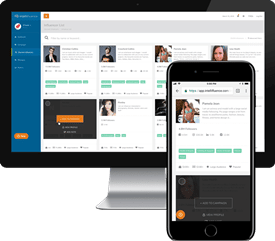Last Updated on June 8, 2020
Now that we have discussed what influencer marketing is and why it should be a part of your strategy, as part 3 of the 14 part series it is now time to cover how to properly assign the right overall goal to your campaign. Goals or key performance indicators (KPIs) can be determined in a variety of different ways. In this particular article we will cover both the BSQ and SMART methodologies for goal setting, show some simple campaign strategies that match the goal you’ve chosen, provide additional thoughts if you’re running a B2B campaign, and of course discuss how you can use Intellifluence in the process.
BSQ is Goal Setting For Those That Think Agile
Covered previously by David Van Rooy, the beauty of BSQ is its simplicity:
B — Think big.
S — Act small.
Q — Move quickly.
By setting big, hairy, audacious goals, you won’t end up limiting your potential to only what you can conceive of achieving in the near-term future. For instance, as of writing we have roughly 11,000 influencing product reviewers in our network. A limited goal might be to reach 100,000 influencers… Whereas my ridiculous goal (until it is no longer ridiculous) is to reach a network size of 5,000,000. The goal is meant to be a major goal, vs something that you can see easily ahead of you.
Acting small in this case simply means taking that goal and dissecting it into achievable milestones. For my own goal that might mean:
- Write 14 blog posts on how to use influencer marketing; soup to nuts.
- Create crash course based on the blog posts.
- Create an ebook based on the course + blog posts.
- Create a video series to discuss each topic.
- Hold a series of webinars with CopyPress to cover the video topics.
- Repeat concept by writing 14 blog posts on how to become a sought after influencer.
- Write an article for {Forbes|Entrepreneur|Inc|Fortune|WSJ|NYTimes|etc}.
- Get next version featured by Appsumo.
- Based on traction, get featured (and probably grilled) by jason (Jason Calacanis) on TWIS podcast.
- Submit 2x version into Product Hunt.
None of those tasks is especially improbable; each simply requires some hard work and harder thinking. As for moving quickly, that’s the most obvious of the BSQ methodology — set a deadline for each task and execute on it.
How does this apply to goal setting for influencer campaigns? Rather than having a goal of 1 sale or 1 review, envision something more grandiose — 1,000+ directly attributed sales via social from 500 posted reviews across 4 different social networks; for acting small it can be based on how you separate outreach with your buyer personas. For instance, if you’re selling sports memorabilia like Dennis Goedegebuure of Fanatics, then you likely have those that root for a specific sports team and those that buy for fashion reasons.
Separating your small tasks into the different personas might involve reaching out to 10 NYC fashion forward bloggers to review Yankees Fitted Hats and another might be to approach 10 Cubs fans to review their respective fitted hat. In terms of quickness, since you’re able to perform 10 outreaches / day without much issue, you could give yourself 3 days for the initial outreach on these two tasks.
The process flows like a waterfall, with more and more outreach and more and more transactions as your product reviewers accept the gig and produce for you, eventually reaching your big goal at some point in the future.
Now Let’s Get SMART
While BSQ is helpful for simply getting moving, with the thesis that any goal is better than no goal (of which I agree), it is possible to be…smarter. Initially conceived of by Dave Chaffey’s team at Smart Insights, the SMART methodology is more nuanced and realistic, which is why I prefer it when determining the ‘S’ portion of my BSQ goalsetting:
S — Specific. The item must be detailed (i.e. 1,000 new brand signups vs more brand signups).
M — Measurable. Fuzzy goals need not apply; we have to be able to actually measure and track the goal
A — Actionable. Within the context of Intellifluence, since there’s actions associated, you’re covered. [Note: in some versions of SMART the ‘A’ stands for attainable].
R — Relevant. Is the goal aligned with your need as a marketer? Sales, visibility, reach…yes.
T — Timeline. Similar to BSQ using deadlines, there needs to be a time-based component.
In my opinion, the biggest difference between BSQ and SMART is that BSQ gets you moving and SMART helps you focus on moving more in the right direction. Theoretically you could assign the wrong big thinking goal, whereas within the SMART methodology that’s less likely to happen since you’re applying critical thinking to whether or not the goal is actionable and relevant. In later iterations of the concept, SMARTER has emerged, with ER representing Evalutate and Re-evaluate — I would agree with this as a post-mortem procedure on any marketing campaign, but for our purposes my KPI on this article is getting you to at least use goals when diving into influencer marketing.

Simple Campaign Boosting Strategies to Get More Out Of Your Goals
You have some goals. You have a rough plan. Let’s maximize those efforts with a few sample strategies:
- Be generous — on our platform, a business and an influencer can negotiate on what activity will be performed and for what type of compensation. However, by going over-the-top you can almost ensure that the review you receive is going to result in an equally over-the-top attention (most of the time). For instance, if you are Fanatics sending out the Cub cap, what if you also threw in some additional Cubs swag? If the persona is a Cubs fan, that’s going to be highly appreciated.
- Re-use content. The product reviewers created some great visual content and wrote some beautiful words about your product. Now what? Aggregate the positive feedback and feature it in an infographic hosted on your own site, sharing back to the very same influencers that you worked with. In many cases as humans, we’re inclined to respond to ego bait and you’ll get some shares from those looking to highlight their own work. This also works as a piece that can be circulated to your prospect email list (if you don’t have one, you need to build one).
- Use secondary influencers for amplification — let’s say in your first round of reviews you ended up with several great blog posts, some tweets, etc. You were smart and also managed to re-use the content for some hosted material for your own site. One simple way to get a lot more out of those reviews would then be to approach those influencers that fit tangentially into your campaign and ask them to promote what was already created. I love these tactics because it allows you to get the most out of created content. While this group of influencers might not be exactly what you want for direct reviews, if they demographics overlap enough, then the spread will result in more of your buyer personas being exposed to the messaging.
What About B2B
Marketers that focus on B2B products and services often find themselves frustrated seeing all the incredible things that can be done with traditional B2C campaigns, but they are usually faced with longer sales cycles, sophisticated buyers, and deal with, for lack of a better word, increased complexity.
Typically we see four rough types of B2B marketing goals:
- Engagement
- Mindshare / Thought leadership
- Customer acquisition (direct sale)
- Lead gen (sales funnel entry)
B2B marketers will be most familiar with SMART methodologies discussed earlier, so these four goal types get folded into the process. On the ‘how’, within Intellifluence specifically, that isn’t fairly easy to explain. Both customer acquisition and lead gen fall into the direct buyer persona approach with the goal of achieving an action.
If the sale can be handled as part of a multi-step form, then it is possible to acquire the minimally required fields like email and name to push into a drip email campaign for lead nurturing; otherwise, if the remaining fields are completed a sale is achieved. For mindshare and engagement, the goal here is more on audience size than specificity, though not mutually exclusive — harkening back to authoritative influence it is still necessary to be relevant in order to achieve mindshare, with not all engagement being equal.
Ask any auto dealership and they’ll tell you the huge time suck between car buyers and tire kickers that lack budget (but are simply in love with the process); engaging time wasters is a good way to waste time that could be spent closing real prospects.
Apply Your Goals in Intellifluence
Once you register for a free trial in the system, you will be presented with the ability to granularly search on the influencers. What is your goal? If you are looking for visibility/mindshare type goals, focus first by selecting a network filter to determine where you want to build that visibility and begin pitching influencers. If you are more focused on customer acquisition and lead generation, you may also want to apply geographic filtering and some clever keyword filters to ensure that your potential list best matches the buyer personas you’ve developed.
After your initial campaign runs its course, consider applying one or more of the simple campaign boosters to get the most out of your Intellifluence experience.
Until next time, be SMART with your campaigns.

Joe, CEO and Co-Founder of Intellifluence, has over 25 years of experience in SEO, leading several successful marketing companies and providing expert consultation. He is the author of The Ultimate Guide to Using Influencer Marketing, which is available as an eBook or in print.






